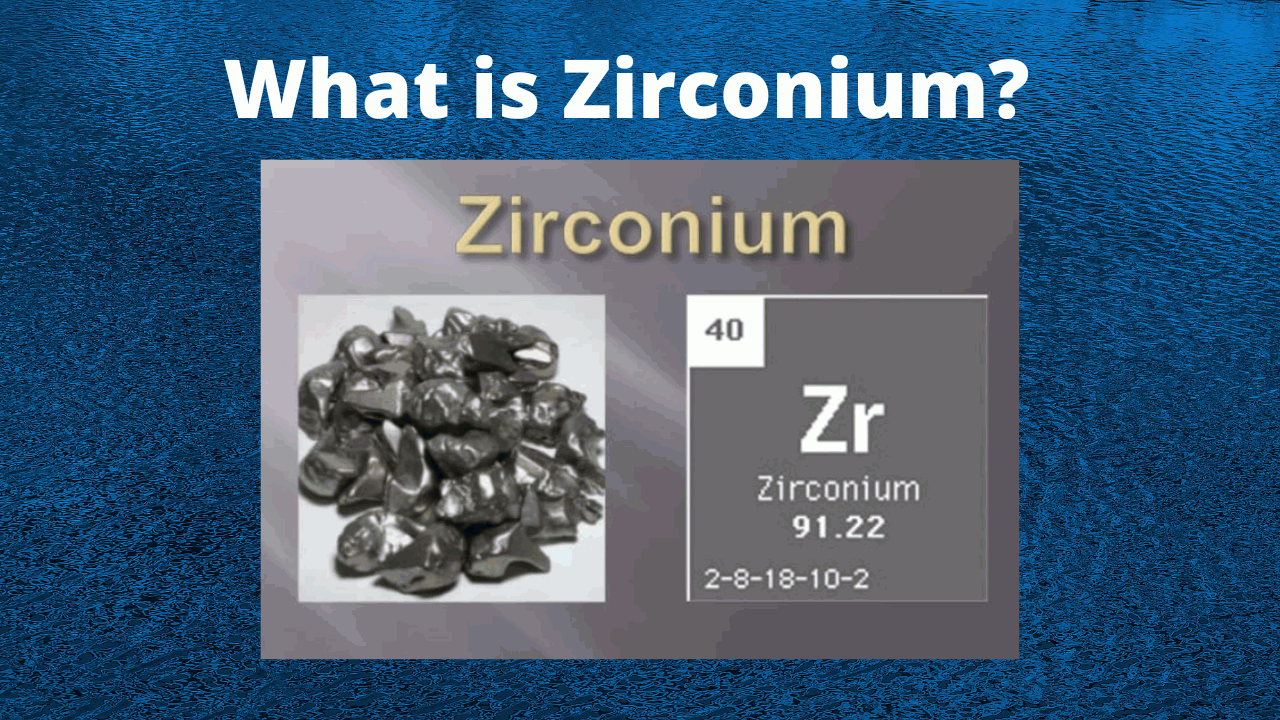
What is Zirconium? Electron configuration, Atomic Number, Uses
Zirconium is a chemical element that is numbered 40 (i.e. atomic number of Zr is 40) in the periodic table of the elements. It is a silvery ductile metal. Metal is similar to steel and has a wide range of uses.
Zirconium (Zr) is contained in the products we are familiar with in a minimal amount. We consume a tiny portion of zirconium along with oatmeal, rice, legumes, vegetable oil, pistachios.
|
General informations of Zirconium (Zr) |
|
|
Symbol |
Zr |
|
Atomic number |
40 |
|
Family |
Transition metal |
|
Group |
4 |
|
Period |
5 |
|
Block |
d |
|
Volumic mass |
6.52 g.cm -3 |
|
Hardness of Zirconium |
5 |
|
Color |
Silvery white |
|
Atomic properties of Zirconium |
|
|
Atomic mass |
91,224 u |
|
Atomic radius |
155 pm |
|
Electronic configuration of Zirconium |
[Kr] 4d² 5s² |
|
Electrons by energy level |
2 | 8 | 18 | 10 | 2 |
|
Oxide |
Amphoteric |
|
Physical properties of Zirconium |
|
|
Ordinary state |
Solid |
|
Fusion point |
1855 ° C |
|
Boiling point |
4,409 ° C |
A little history of Zirconium
Etymology of Zr
The name of element 40, zirconium, derived from the word zircon. In fact, zircon is a semi-precious stone composed essentially of zirconium silicate, with the formula ZrSiO4, which can take on yellow, blue, brown, green, orange or red and sometimes purple hues. Thus, the name zircon derives from the Persian zargun designating the color of gold.
The name zirconium was suggested in 1808 by British chemist Humphry Davy. Humphry Davy is an English physicist and chemist and He discovered many chemicals such as potassium, calcium, sodium, magnesium and strontium.
Discovery of Zr
Zirconium is a semi-precious stone mentioned in antiquity, but it was not until 1789 that the German chemist Martin Heinrich Klaproth discovered that it contained a new chemical element.
By analyzing zirconium he obtained the oxide of a still unknown element which he called zirconia, it was zirconium oxide with the formula ZrO2 .
In 1808 the British chemist Humphry Davy tried to isolate this new element by electrolysis, he did not succeed but nevertheless proposed to called it zirconium.
It was not until 1824 that the Swedish chemist Jons Jakob Berzelius managed to obtain metallic zirconium.
Presence in its natural state
Zirconium is mainly present in an ore called zircon, with the formula ZrSiO4 , which can sometimes be in the form of a gemstone called hyacinth.
In addition, zirconium is not found in the native state since it is generally associated with titanium and hafnium. Main constituent of granite, it is found in great concentration in granite sands.
Physical and chemical properties of Zirconium
Zirconium comes in the form of a hard, silvery, satin-finished metal. It is also found commercially in the form of shiny flakes or gray powder.
At ambient pressure , it exists in two allotropic forms : compact hexagonal under 863 ° C, and centered cubic beyond. A stable oxide film makes it very resistant to corrosion . Its chemical properties are close to those of hafnium.
Zirconium as a single body
Element 40, zirconium, is a greyish and shiny metal which does not exist in its native state, it is not very reactive, does not react with water or with bases and rarely with acids.
On contact with dioxygen, it oxidizes and is covered with a layer of zirconium oxide but in divided form, i.e. in powder form, which can undergo strong oxidation and ignite.
Zirconium ions in aqueous solution
Zirconium IV ion, of formula Zr 4+ , is a monoatomic cation with a defect of 4 electrons.
It is stable in an acidic medium but in a basic medium it precipitates, forming zirconium hydroxide.
It can be formed by reaction between zirconium oxide and an acid.
Zirconium compounds
Zirconium oxide, with the formula ZrO2 , is a compound which is most often synthesized but which also exists in the form of a natural mineral called zirconia. It is used to obtain the most faithful imitations of the diamond.
It forms naturally on the surface of metallic zirconium by oxidation with oxygen in the air.
Isotopes of Zirconium
Zirconium is a chemical element that has 33 isotopes which have a mass number between 78 and 110.
Among these isotopes, only 4 are stable:
- Zirconium 90, representing 51% of natural zirconium
- Zirconium 91, representing 11% of natural zirconium
- Zirconium 92, representing 17% of natural zirconium
- And zirconium 94, representing 17% of natural zirconium
In addition, zirconium also has 5 nuclear isomers.
In addition to these nuclear isotopes and isomers, zirconium also has a natural radioisotope, zirconium 96, which decays through double beta decay and has a very long half-life.
Uses of Zirconium (Zr)
Zirconium alloys are used in many areas of industry: nuclear power, rocket and aircraft construction, instrument making, foundry, military production.
The main use of zirconium is in the form of zircon in tiles . Pure metal is used as a coating in jet engines. Chemical furnaces and reactors also have their inner walls protected by zirconium as a refractory material.
Zirconium is also used for the cladding of nuclear fuel pellets in pressurized water reactors.
Zirconia, cubic zirconia, is used to make rhinestones . As a surface treatment on glasses, it protects against scratches. Zirconium oxide is also present in some ceramic knives.
Toxicity of Zirconium
Zirconium is a chemical element which has a low level of toxicity. However, its radioactive isotope, because of its long half-life, remains and will remain for centuries a danger with regard to the appearance of genetic mutations and cancers.
Zirconium is not considered to be an ecotoxic element. Indeed, it is unlikely to present a risk to the environment.
Know about more periodic elements- Gadolinium, Germanium, Neon, Oxygen, Potassium, Promethium, Selenium, Sodium, Terbium, Tellurium, Yttrium, Ytterbium, Zirconium
Related Articales
Recently Posted
-
भगवान गौतम बुद्ध जीवन परिचय | Gautam Buddha in Hindi
December 15, 2022. -
कार्बन के अपररूप Allotropes of Carbon in Hindi
November 5, 2022. -
मिश्र धातु किसे कहते हैं? उपयोग, नाम, गुण Alloy in Hindi
July 27, 2022. -
गलनांक किसे कहते हैं? परिभाषा, उदाहरण Melting Point in Hindi
July 20, 2022. -
परिमाप किसे कहते हैं? Perimeter in Hindi
July 19, 2022.




